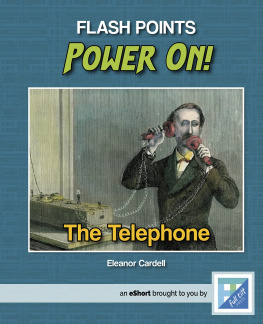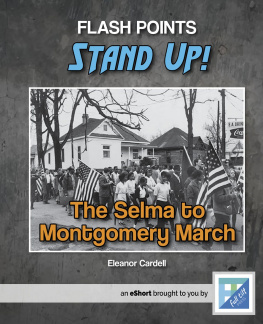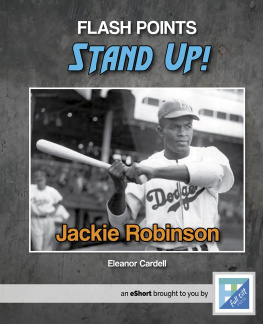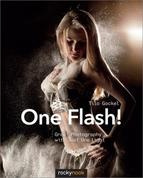
The Telephone
March 10, 1876
Alexander Graham Bell sits quietly at his desk
in a busy machine shop. He is focused on a
small toy-like machine made of metal and wood.
He has nally nished building his telephone. He
spent years trying to get it right. He tried hundreds
of dierent designs. Now he is ready to test it.
Bell ignores the sounds of other workers around him.
Metal clangs. Wood creaks. Electricity hums. Bell puts his
face against the wooden top of the device. He speaks into
his telephone.
Mr. Watson, come here. I want to see you.
Bells chair creaks as he leans back. Moments later, he hears footsteps
pounding up the stairway outside the lab. His assistant, omas A. Watson,
bursts in. Watson has just run up three ights of stairs. He had been sitting at
a similar device, a long wire connecting the two. Watsons face is ushed. His
breathing is loud. He cries, I can hear you! I can hear the words!
Bell has just made the rst telephone call.
2 Flash Points

The rst telephones were
so big and heavy they had
to be mounted on a wall
or put on a sturdy table.
Did you know?
One of Bells very rst
telephone designs used an
actual ear from a dead body.
Power On!

How and Why
e creation and use of new technology is a process. Many dierent
people, events, and ideas come together when new technology is needed.
Below are some things that led to Bells invention of the telephone.
An Old Idea
People had been trying to send
messages across great distances
for hundreds of years. ere
are records of people trying
many dierent devices since
the 1600s. But early machines
couldnt send messages very far.
Experience with Sound
Alexander Graham Bell was very
interested in sound. His mother was deaf.
His father taught deaf people how to
speak. Bell also worked with deaf people.
He thought a lot about speech and
sound. He wanted to build something
that could send sound electronically.
4 Flash Points

Previous Invention
In the late 1800s, the telegraph
was the fastest way to
communicate. Messages were
sent along a wire using electricity.
ey were sent in code, then
translated at their destinations.
It was a slow process. At this
time, people were traveling more.
ey wanted to talk to each other
more quickly. e telegraph
needed to be replaced.
Competition
Another inventor,
omas Edison, was
already well-known for
his inventions. His work
improved the telegraph.
For years, Edison and
Bell were both trying to
nd a way to transmit the
sound of a human voice.
ey were competing to
invent the telephone.
Power On!

What Happened Next
Bell and Watson continued to work on their
telephone for weeks aer the rst phone call
worked. ey made changes to the design. ese
changes improved the quality of the sound.
Two months aer his rst phone call, Bell went
to the Centennial Exposition in Philadelphia,
Pennsylvania. Many famous scientists were there.
ey thought his invention was amazing.
However, other people did not like the new
device. e telephone confused some people. It
made them uncomfortable. People called Bell a
liar. ey accused him of using witchcra. For
several years, Bell and Watson showed many
people the telephone. ey explained how it worked.
Slowly, people began to change their minds.
In April 1877, the rst telephone line was installed. Charles Williams was
Bells boss at the machine shop. For years, he gave Bell money and space
to work on the telephone. So Bell decided to install a telephone line for
Williams. e line ran between Williamss oce and his home. It was
miles (5 kilometers) long. Williamss telephone was very successful.
More and more people wanted to get a phone of their own. Williams
started building more phones. His company made phones per day,
and rented them to people. Soon, they spread across the United States.
6 Flash Points

In 1884, dozens of important
people watched Bell make the rst
call from Boston, Massachusetts,
to New York City a distance of
miles (378 kilometers).
Did you know?
By August, 1877 only four months after
the rst telephone line was installed
phone lines were working.
Power On!

Ripple Effects
A single event, no matter how big or small it may seem at
the time, can have a big impact on the future. e creation
of the rst telephone changed the world in a big way.
AT&T
Many new companies
had to be formed to
handle the new telephone
lines. One of the rst was
the American Telephone and
Telegraph Company. It was
started in 1885. Today, the
company is known as AT&T,
and is one of the largest
phone companies
in the world.
Cross-Country
In 1915, AT&T built the rst
telephone line across the US.
It reached from New York to San
Francisco. Alexander Graham
Bell and Thomas A. Watson
made the rst phone call
across the country.
8 Flash Points

Emergency
Contact
Before phones, it was hard to
contact the police. Someone had to
go to a police station. But even once
phones were common, it was still dicult.
In 1968, the Federal Communications
Commission decided they needed
an emergency phone number












![Emanuele Feronato [Emanuele Feronato] - Flash Game Development by Example](/uploads/posts/book/120345/thumbs/emanuele-feronato-emanuele-feronato-flash-game.jpg)








